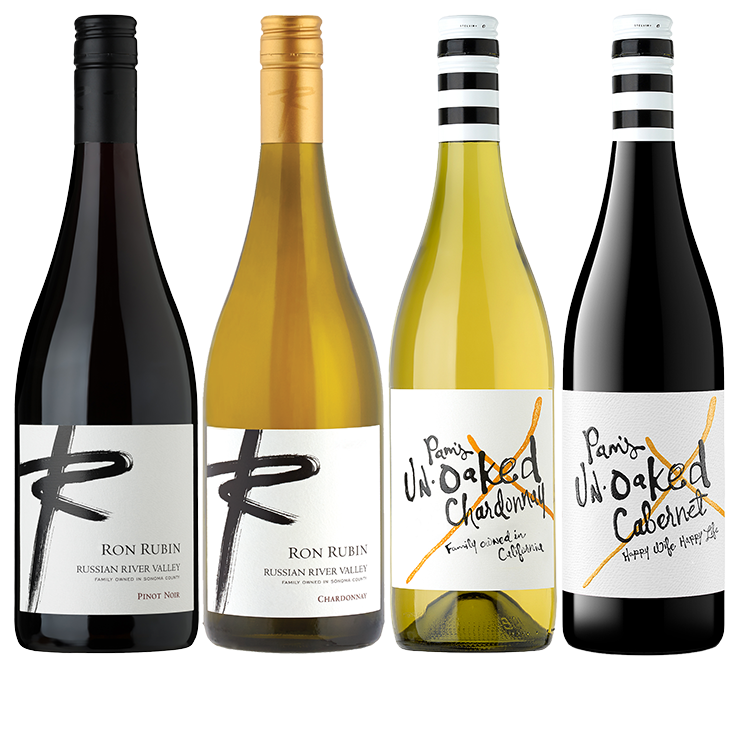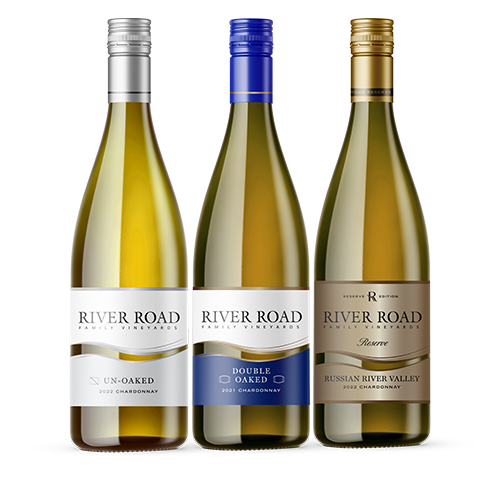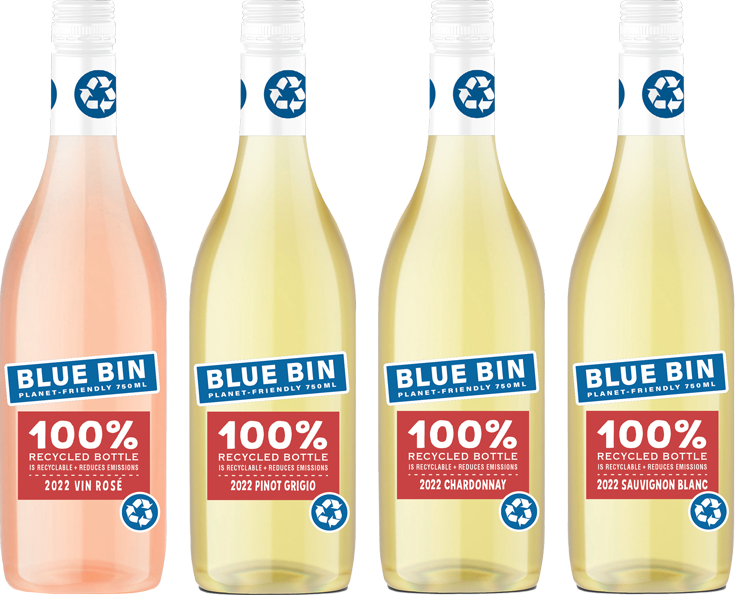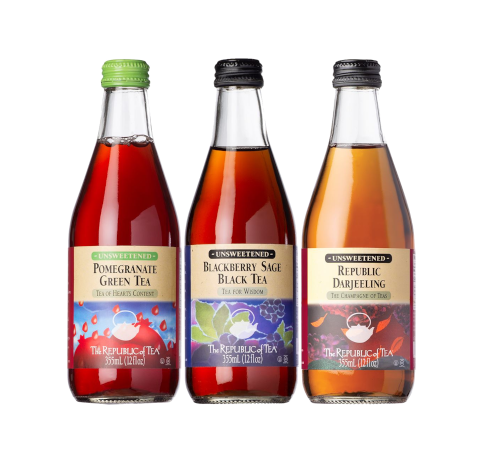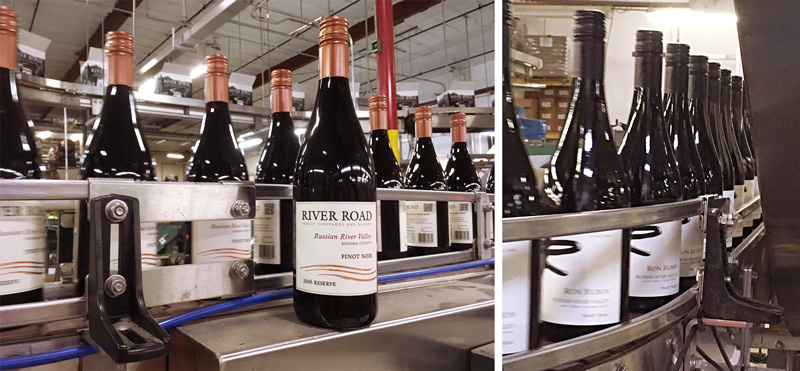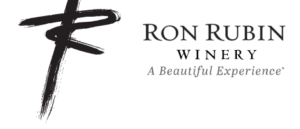BOTTLING
At Ron Rubin Winery, June was a big bottling month for us. In addition to the Ron Rubin 2016 Russian River Valley Pinot Noir, we also bottled several wines, for our River Road Family Vineyards and Winery label. The 2016 Russian River Valley Chardonnay and Pinot Noir are now in the bottle! So, why do we choose to bottle these wines in June? What factors into our decision each season, to bottle (or can) our wines?
A simple answer is that we have three different broad windows for bottling, depending on the style and varieties of wine being produced:
#1. Earliest bottling blends tend to be low-tannin, white wines, or rosé. These wines have a fresh, fruit-driven personality, and don’t need extra time, for softening and oak extraction. In fact, they would lose a lot of what makes them so special, if we delayed bottling until later in the year. Typical bottling times for these wines are December through March of the year, following harvest.
#2. The majority of wines we produce are light-bodied, red wines and barrel fermented Chardonnay. These wines are produced using high quality, oak barrels. We want to give the young wines a chance to interact with the oak, and to extract some of the desired aroma, flavor, and textural elements the toasted oak provides. If we bottled too soon, the wines would show a raw wood, “planky” flavor, as the integration of oak and wine hasn’t yet occurred.
Conversely, if we wait too long before bottling these light-bodied wines, the signature fresh fruit of our Pinot Noir, Chardonnay, and Pinot Blanc might be lost, never to return in the bottle. After decades of experimentation, I’ve determined that an aging period of eight to nine months is ideal, for most of our Russian River Valley wines. Typical bottling months for our Russian River Valley Pinot Noir, Chardonnay, and Green Valley Pinot Blanc fall between June and August of the year, after harvest.
#3. Finally, a small number of our wines (usually our single vineyard wines) have the opportunity to remain in barrels, through the harvest, following their vintages. For example, this means that our 2016 Ron Rubin Green Valley Cool Climate Syrah will not bottle until after the 2017 harvest is complete. We schedule our mobile bottling truck to return in early to mid-November, to bottle these special, small production wines
Certainly, other factors weigh into our decision making. Getting our wines into consumers’ hands, during the right season, is important. (We wouldn’t want to miss the spring and summer season with our beautiful Un-Oaked Chardonnays, for instance.) The most important concern, however, is elevating the wine into its best possible expression.
WARM WEATHER
On June 18, hot weather arrived in Sonoma County, with an unusually high temperature of 106 degrees Fahrenheit. While it’s not unusual for us to hit the 100s, on one or two days in June, what made this heat wave atypical was the lack of fog and its cooling, night-time effect. Spending an evening outside in shorts and flip-flops is an unusual experience, along the Sonoma Coast, during summer!
The heat, although a bit much for my comfort, was a good thing for our grapevines. As I’ve mentioned in earlier columns, our soils have high levels of available water this year. This provided the vines with ample moisture to weather the heat, and helped to dry the soils a bit faster. Since we want to stress the vines slightly, as we approach the ripening phase, this drying gets us closer to our goal.
Another distinct advantage is the effect on mildew, which is a constant threat in the Green Valley of Russian River Valley. We’ve experienced higher than normal humidity this spring, so mildew pressure was very high and required constant vigilance. It’s been shown that active mildew is killed by temperatures over 95 degrees, so the June heat wave had the wonderful effect of lowering the risk of damage, to our beautiful fruit!
VINEYARD UPDATE
As you can see in the pictures, the vines are still actively growing, despite June’s heat. With the extremely wet winter, balanced nutrition, and a few late spring rains, they had a surplus of resources available. And, it sure shows in the vineyard. We’ll continue to manage vigor, by using a lot of hand tending, and by maintaining a balance between leaf surface area and cluster weights.
Here’s the primary work Alvaro is doing in the vineyard in June and July:
Hedging ~ Once the vine shoots have reached the top of the trellis posts and we can’t move the catch wires any higher, the shoot tips begin drooping into the space between the rows. Since our prevailing winds tend to come from the northwest, the vines hang over the east side of the trellis, creating a “comb-over” effect. Eventually, we’re unable to drive the tractor through the vineyard without catching on these long shoots; so, they need to be cut back. We call this “hedging” the vineyard, and the immediate result is a tidy, uniform look to the vineyard.
One downside to hedging – Once we’ve clipped off the growing tip on the vines, they’ll not take the hint and stop growing (unless they’re ready to stop). Any remaining vigor has to go somewhere. And, in the case of grapevines, it’s in the growth of “lateral” shoots. These shoots sprout from along the primary shoot, and grow sideways out of the vertical hedge, seeking light between the vine rows. This results in additional hand work, to remove these laterals and maintain our vine balance.
Leaf Pulling ~ Alvaro has also been busy removing leaves, from the “morning” side of our vines. As our vine rows are oriented north/south, the first sunlight of each day illuminates the east side of the vines. By exposing the grape clusters on this side, we can use the sun’s energy to dry out the dew that’s formed on the grapes overnight. This is a natural way to limit fungus growth on the grapes. We don’t remove the leaves on the west side of the vines, as they’ll shade the fruit during the hot afternoon hours, preventing sunburn. In 2010, a sudden heat spike caused widespread damage in Sonoma County’s vineyards, teaching growers throughout the area an expensive lesson, against aggressive leaf pulling!
As you can see, it takes a focused effort in the vineyard, to produce wines of great quality. Our team is committed to making sure you can enjoy a beautiful tasting experience!
Cheers!

